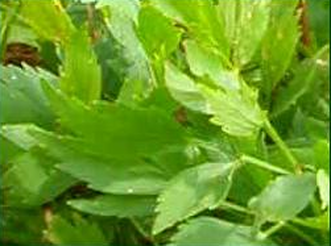
Lovage Levisticum officinale Apiaceae (celery family )We usually say that herbs like a fairly dry soil. For those who are looking for a herb that will like the wet ground we have now, we have the answer. Lovage is not a well- known herb but is one well worth getting acquainted with.
It is a tall striking plant growing from a long, thick taproot that sends out hollow central stalks with many branches. The leaves are dark green, shiny and deeply divided resembling overgrown celery. When dried, the leaves look and smell like celery. Many people would be surprised to find that the taste of the European flavour, Maggi, comes from the lovage plant.
Another surprise comes in watching this plant grow. The first year I grew this plant it was like being in a Jack in the Beanstalk movie as it got higher each day. I had no idea how high it would grow so did not harvest it until it reached its full six feet. The seed heads that developed reminded me of giant dill seed heads.
You may want to buy several plants as it is one of the few herbs that can be used in so many ways. The tender new leaves and stalks can be added to spring salads. The leaves with their celery taste can be added any time you don't have celery in the fridge. Lovage rates with celery in the amount of sodium it contains (2.3%) so can satisfy the desire for saltiness without added salt.
Harvest the leaves while they are still dark green and lush and before they flower. Dry flat on screens in a cool room until crisp then store in a jar for winter use in soups and stews. If you let some of the stalks go to seed you will have large umbrels with brown seeds. These seeds can be added to breads and biscuits or the umbrels can be hung upside down for spectacular dried arrangements. These tall ornamental plants add height and interest in a herb or mixed border bed . They self- seed proving sufficient plants for future use or to share with friends.
It is a tall striking plant growing from a long, thick taproot that sends out hollow central stalks with many branches. The leaves are dark green, shiny and deeply divided resembling overgrown celery. When dried, the leaves look and smell like celery. Many people would be surprised to find that the taste of the European flavour, Maggi, comes from the lovage plant.
Another surprise comes in watching this plant grow. The first year I grew this plant it was like being in a Jack in the Beanstalk movie as it got higher each day. I had no idea how high it would grow so did not harvest it until it reached its full six feet. The seed heads that developed reminded me of giant dill seed heads.
You may want to buy several plants as it is one of the few herbs that can be used in so many ways. The tender new leaves and stalks can be added to spring salads. The leaves with their celery taste can be added any time you don't have celery in the fridge. Lovage rates with celery in the amount of sodium it contains (2.3%) so can satisfy the desire for saltiness without added salt.
Harvest the leaves while they are still dark green and lush and before they flower. Dry flat on screens in a cool room until crisp then store in a jar for winter use in soups and stews. If you let some of the stalks go to seed you will have large umbrels with brown seeds. These seeds can be added to breads and biscuits or the umbrels can be hung upside down for spectacular dried arrangements. These tall ornamental plants add height and interest in a herb or mixed border bed . They self- seed proving sufficient plants for future use or to share with friends.
